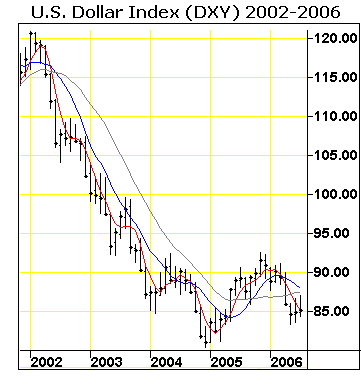us powerhouse? bemerkungen zu us aktien
dank geht an mish und sein markettraderforum und bill bonner
http://www.markettradersforum.com/forum1/1452.html
http://www.dailyreckoning.co.uk/printerfriendly/view.asp?idarticle=1459
highlights:
we watch the wobble of the Dow and think about all those millions of shareholders who must be getting a little tired of holding stocks ‘for the long run,’ wondering if the long run will last longer than they will. It has been eight years with no growth whatsoever in stock prices. As for the Nasdaq...don’t even mention it. All investors have gotten for their pains is a puny, pathetic dividend yield of less than 2%. After taxes and inflation, they’re losing money.
So, what would it take to bring the Dow down sharply? What would it take to turn sentiment negative? What would it take to turn blue skies dark? Probably not too much, is our guess.
What is an investor to make of all this? Take the sentiment out; examine the picture coldly. Stocks are still near their highs, not their lows. They are still expensive, not bargains. What could he hope to gain from them? Dividend yields do not even match inflation. In order to make him any money, his stocks would have to go up in price. But what would possibly make them go up at this point? Higher earnings? Lower interest rates?
As to the second, if rates go down again this time around, they will more likely be signaling a wilting economy rather than a growing one. Stocks could, of course, go higher even if the economy slumps, but when stocks are already so high, we wouldn’t bet on it.
As to higher earnings, a note in today’s mail shed a sobering light on the ground that is being lost:"In many ways, the last few years should have been a golden era for American manufacturers. Since 1997, the productivity of US factories has soared, rising at a 4.6% annual average rate. That's the fastest sustained rise in manufacturing productivity in at least 40 years, and well ahead of the 1960s heyday of US industrial prowess.
"Yet despite these gains, the US factory sector all but imploded. Domestic factory output is still down 2% from its 2000 peak, while imported goods are up 8%. Some 3 million factory jobs - one in every six - have been lost since the last peak in mid-2000. And while the manufacturing sector is finally expanding and hiring again - up 37,000 jobs since January - no one expects domestic manufacturers to ever recover the ground lost to overseas competitors.
"Economists, business leaders, and politicians give all sorts of reasons for the dire state of US manufacturing: Competition from low-wage offshore factories, an excessively strong US dollar (dann lese ich den chart wohl verkehrt..., high corporate taxes, and the rising bill for employee and retiree benefits.

"But there's a more surprising explanation for why US manufacturers have fared so poorly. Fact is, as fast as American factories have improved productivity and cut costs, foreign competitors in Asia and Europe have charged ahead even faster.
"To this jeremiad, we add an illustration from the Financial Times: Since October 2000 the dollar has lost 35% of its value against the euro. The decline ought to have handed American exporters a golden opportunity to increase sales in the eurozone and bring down the trade deficit with the area. But the US-Europe trade deficit actually went up during the period – it doubled. (warum auch hierzulande die usa immer noch wirtschaftlich als powerhaus oder vorbild gesehen wird erschließt sich mit von tag zu tag weniger)
What do we make of this?
Lesson one: it will take more than a decline of the dollar to revive manufacturing in the US and balance trade. It will take a genuine change in sentiment that makes Americans reluctant to buy anything at all, including things made overseas. And, that will take a serious recession...
Lesson two: an investor has more to lose than gain by diving into US stocks now. There is little hope of much upside and the downside is vast.
Little by little – or all of a sudden – sentiment is going to change toward the downside. We see it already. House prices are no longer rising; in some areas, they have begun falling. Stocks have gone nowhere for a very long time, certainly not up. America’s military adventures are bogging down. Commuters are running out of gas. Consumers are running out of money. Energy and commodity prices are still rising, showing little signs of coming down.
The Empire is peaking out...it is going broke
zur person bill bonner muß man noch anmerken das der "empire of debt" verfaßt hat. sehr empfehlenswert. gluabe das bald auch ne deutsche übersetzung kommen soll.
wenn man sich die zahlen im bezug auf die usa und auch die us vermögenswerte ansieht ist klar das so gut wie jeder auslandsinvestor die letzten jahre aufgrund des $verfalls nur zugesetzt hat.
schon verwunderlich wie von usa seite immer propagiert wird das die ausländer das defizit ja deshalb finanzieren weil die anlagerenditen in den usa halt überdurchschnittlich seien. das der überwiegende teil der finanzierung von notenbanken kommt die nicht renditegetrieben sind wird gerne "vergessen" perfektes besispile für so ein irrationales verhalten hier:immobilienblasen: wie rational ist china? / importierte inflation
gruß
jan-martin
![[Most Recent Quotes from www.kitco.com]](http://www.kitconet.com/charts/metals/gold/t24_au_en_usoz_2.gif)
![[Most Recent Quotes from www.kitco.com]](http://www.kitconet.com/charts/metals/gold/t24_au_en_euoz_2.gif)

0 Comments:
Post a Comment
<< Home